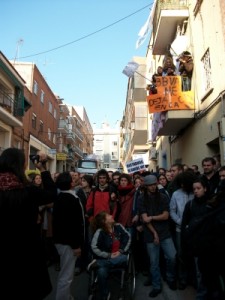
“If they throw us out, I don’t know what we’re going to do. Now we have nothing,” says Trini, who lives with her partner and son in a squatted building in central Madrid. The €500 she earns taking care of seniors is the only income her family has. Trini wants to buy or rent a house, but at a price that her family can afford.
Trini is part of a massive squatting wave that is sweeping across Spain as a response to the failure of public housing policy. Once, squatting was seen as an act of defiance, done mainly by young people. Now it is more commonly done out of necessity, by families who feel they have no other option.
Since 2007, there have been more than 350,000 evictions as a result of unpaid mortgages. Many of these have left entire families without homes. This is despite the fact that there are six million empty homes across Spain, most of them owned by banks.
Miloon Kothari, Special Rapporteur on the Right to Adequate Housing for the UN, recommended in vain to the Spanish government in 2008 that it take steps to lower the price of housing. Another suggestion was that the government increase the number of social leasing homes, which in 2009 was 1 percent of homes, five times less than in Italy and 35 times less than in Holland.
Since 2005, social collectives such as the Platform of Adequate Housing and V de Vivienda had been demanding that the government take measures. In 2009, the Platform of People Affected by Mortgage (Plataforma de Afectados por la Hipoteca, or PAH) asked the government to ensure the cancellation of families’ debts on giving their home back to the bank, and in November, 2010, it decided to take direct action to stop evictions by gathering activists in the homes of those affected. “We knew that it was a problem because people were over-indebted paying off their homes. But what we didn’t know was that the law can put Spanish people in debt for life,” says Ada Colau, one of the founders of the PAH.
Today, more than 160 evictions have been stopped, and the PAH has negotiated with the banks for hundreds of supportive leases for the affected families. One of the most recent halted evictions was that of Yheimy. When she could not keep up mortgage payments, BBVA took back the home for 50 percent of its original value, leaving Yheimy owing €200,000 in interest and legal fees (and the rest of the unpaid mortgage, subtracting the mentioned 50 percent and the money already paid by Yheimy). “This is a shame! We can stop this!” shouted the 50 or so people who went to support Yheimy and stopped the eviction.
In recent months, the PAH has been bolstered by the involvement of the 15-M, or indignados movement (although many within the movement are not keen on that latter moniker), which started in the spring of 2011.
“Before, the squatting and housing movement worked separately, and now, with the 15-M movement, they have converged and this has given them strength,” explains Miguel Ángel Martínez, a sociologist at the Complutense University in Madrid and a member of the Squatting Europe Kollective.
Members of the 15-M movement have occupied almost 50 empty buildings and given them a social use. Since last year, activists have occupied eleven buildings in Madrid, although some of them were evacuated by police. The chosen buildings are diverse, mostly owned by the state, and have been empty for years: hospitals, markets, theatres. Now these buildings are the assembly places for the collectives of 15-M, and they offer free cultural, educational and leisure activities organized by the people of the neighbourhood.
But those involved in this squatting movement face plenty of resistance, not least from the banks that own the empty properties in question.
The new financial institution Bankia owns a building near Embajadores square, in Madrid, which was squatted in January. “In a few days, Bankia reacted and put private security at the entrance of the building,” explains K., a young man of 25. Although the security staff hired by Bankia are not legally authorized to identify or detain anybody, they exert pressure by asking everyone that comes into the building which flat they are going to and why. They block the entrance if they do not receive a satisfactory answer. Other neighbours in the building have complained about this, claiming that it is an attack on their privacy.
A common front
“Most of the people living here support the squatting. We are a common front,” says K. The bank has also walled up nearly 50 empty apartments in the building to avoid them being used by squatters. Like Trini, K. has been forced to squat for economic reasons, but he says there are also political ones. “If the law is not just, justice has to bypass the law,” he says, paraphrasing Jean-Luc Godard.
According to Miguel Ángel Martínez, there is more “invisible squatting than political squatting.” The Housing Department in Madrid says that today, nearly 460 public housing homes are being squatted in the city. “This is a minority situation, but without a doubt there is an increase in squatting,” explains an official of the Housing Department. This number is only a small fraction of the number of squatted homes, most of which are privately owned.
The Squatting Office in Madrid gives support to 15 people interested in squatting each week. “The profile has changed a lot since 15-M. Before, young people and some seniors with economic problems asked for advice. Now there are a lot of families coming to us,” explains S., one of the members of this office.
Thanks to Sebastian Kolendo for his help with this article.
Leave a Reply
You must be logged in to post a comment.